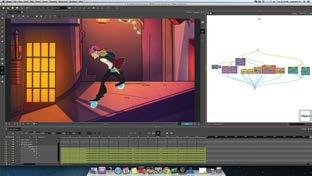
4 minute read
Looking Back to the Future
Visual-effects artists evoke yesteryear’s optimistic view of the future for director Brad Bird’s Tomorrowland. By Bill Desowitz.
Walt Disney envisioned Tomorrowland — an original Disneyland attraction that opened in 1955 — as an inspiring and optimistic vision of the future, full of sweeping towers, clean open spaces and life-improving conveniences science could only hint at.
But in turning that vision into the feature film Tomorrowland, which hit theaters May 22 from Disney, it was the contrast provided by later years’ pessimism and darker visions of the future that appealed to director Brad Bird, writer-producer Damon Lindelof and star George Clooney.
To bring the visuals of the story to life, the filmmakers tasked ILM with creating the landscape of Tomorrowland, which incorporated Disney’s Experimental Prototype Community of Tomorrow, or EPCOT, idea of urban planning as well as a recreation of much of the 1964 New York World’s Fair, where Disney premiered “It’s a Small World,” along with “The Carousel of Progress,” the animatronic attraction “Great Moments with Mr. Lincoln” and the famous PeopleMover.
ILM worked on the pavilions, set pieces and set extensions of the World’s Fair, which was comprised of full CG environments.
“Brad had a real affinity for the World’s Fair, that stylized 1964 look,” says Eddie Pasquarello (The Avengers), visual-effects co-supervisor with Craig Hammack (Star Trek) on Tomorrowland. “He was very articulate about matching the World’s Fair and we knew where we had to go.”
The movie is about a scientifically curious and optimistic teen played by Britt Richardson who learns Tomorrowland is real and tracks down Clooney’s Frank Walker to reach it. The movie also features Hugh Laurie as the brilliant villain David Nix, and required three different visions of Tomorrowland: a 1964 version, a 1984 version and a dystopian future version, each of which required its own flavor.
Seeing Triple
“For Tomorrowland, he really wanted to convey a mood in each of the three experiences,” says Pasquarello. “While it’s under construction in 1964, it needed to have a certain optimism to it. Years went into the planning with architects and ILM, and it truly was a city planning adventure. Brad had a hand in the layout and where buildings were placed.”
The idealized Tomorrowland has large fountain, sprawling grassy areas and curvaceous architecture that is shiny and eco-friendly. The main area is Bridgeway Plaza, which contains a tower that’s the centerpiece of Tomorrowland.
Above that orbits the monitor sphere that produces all of the energy. Everything around and above Bridgeway Plaza is fully CG.
Fortunately, thanks to a series of convenient coincidences, Tom Peitzman, the visual-effects producer and the film’s co-producer, stumbled on a futuristic-looking location that they were able to use for part of Tomorrowland: the City of Arts and Sciences in Valencia, Spain. Designed by Santiago Calatrava, whose work was already inspiring Tomorrowland production designer Scott Chambliss’s work, the discovery of the City of Arts and Sciences also dovetailed with Bird’s preference for using physical locations over virtual sets.

Getting Real
But the crew had to construct in Vancouver its own set for Bridgeway Plaza, which was half the size of a football field and featured a full-size monorail system known as the levitating elevated vehicle.
Sitting atop a track that rises 16 feet in the air, the monorail train weighs about 35,000 pounds. With the safety of the cast and filming requirements in mind, the crew used hydraulic winches that could shut down the set very quickly in an emergency and brakes to stop the monorail on a very specific mark and have the doors open automatically.
But then everything goes wrong in Tomorrowland when all the optimism is pushed aside in favor of monolithic power generation and it grows dark and ugly.
Speaking of energy, all of the energy effects were based on Nicola Tesla’s famed Tesla coil. “Brad wanted us to keep that in mind and we would customize it for a weapon or the portal or the monitor sphere,” says Pasquarello.
The portal is a way of transporting from Tomorrowland using a rippling, electrical energy force. This was inspired by tachyons — hypothetical particles that move faster than light.
For the environments, ILM used 3ds Max and the V-Ray rendering engine. Barry Williams, head of CG environments, led a team of generalists that built Tomorrowland in its various stages. CG supervisor Greg Kegel was in charge of the dystopian Tomorrowland at ILM’s Vancouver studio.
ILM also contributed the animated robots under the supervision of Maia Kayser (Rango). The most prominent are the big, round and white Goliath construction bots. Given their heavy design, personality is primarily conveyed through moving their clunky parts: large utilitarian arms with drills and other tools. “They feel like a big monorail and have a quaintness to them,” Pasquarello says.
Of course, there’s a bad version of the Goliaths in dystopian Tomorrowland called SenMost of the futuristic skyline of Tomorrowland is CG, with the production creating three versions of the city.


tinels. They are fighters and figure prominently in the climactic action sequence at Bridgeway Plaza.
There’s also the young humanoid Athena (Raffey Cassidy), who provides the pin access to Tomorrowland in the hope of finding a savior. She’s all CG when performing fantastical feats, such as fighting inside the Blast from the Past retro shop in Houston or running at bionic speed.
The bots, like everything else, fit right into the future retro vibe of Tomorrowland.










